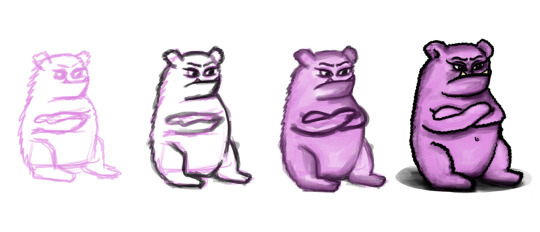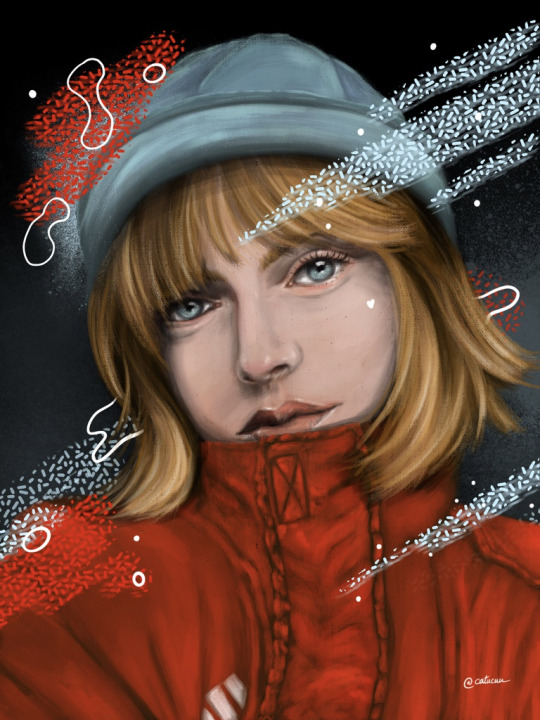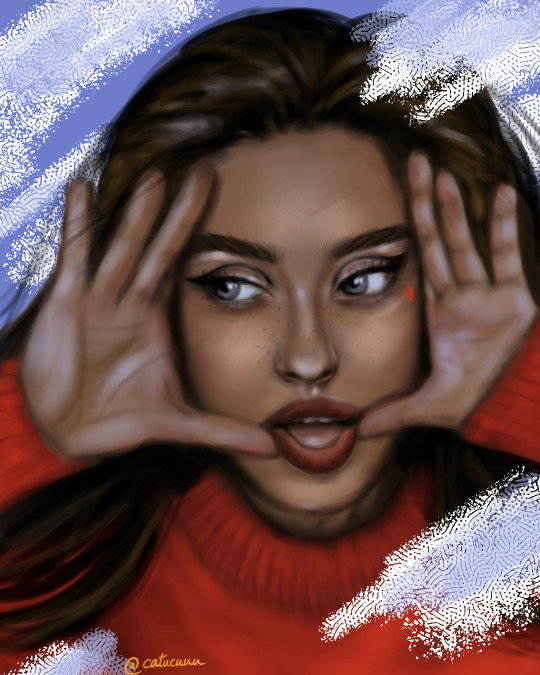#catucuu
Explore tagged Tumblr posts
Text
Style hunting
Free the Monsterind
In my constant struggle of finding a unique drawing style, I faced many creative blockages that were crucial to my overall development.
The whole experience was like a rollercoaster of emotions: encouraging myself to draw, choosing a subject, letting my mind free and start sketching, adding colours, trying not to be picky on brushes and experiment different types and different textures without following any patterns, having that boost of energy and enjoying the moment while listening to music, feeling the dopamine rush, being excited when I considered the drawing looked good enough and any other changes would decrease its quality, then opening my social media account, returning to the drawing application and see the monster staring at me (Janda, 2013).
A long-phrase that sums up my past two years.
Is the “monster” that follows many artists worldwide. But it is the same “monster” or we all have different ones? At this moment my mind would turn to 180 degrees and see the final form of my drawing as being “ugly” and immediately my reaction would be to close everything and do not show my creation to the online world.
I found myself wondering how the monster would look like and this was the image that popped into my mind the minute after, so I started sketching again. Not a ferocious beast, but a snob fluffy mauve creature being too spoiled to remain grateful for what he has.

Mind monster (Cimpoesu, 2020)
Starting to ask myself what is happening in my mind whenever I finish a drawing, was a promiscuous start. Why was I so concerned about what the others might think about my work? And why all of a sudden I would just have transposed myself into somebody else’s body and start judging my art, forgetting all the feelings I have had when I was creating it? Was my art supposed to carry any hidden meanings to anyone that might have seen it?
Art is subjective and does not represent pure tangible knowledge. Moreover, its purpose is to suggest and be interpreted by anyone who sees it (Scrivener, 2002). Thinking twice, every piece of art can include a small amount of knowledge due to the power of imagination and analysis its creation process.
Scrivener’s vision was that art in any form cannot embody pure knowledge either in-the-making process nor in the final-created object. This statement is half true from my perspective, for one reason: art, in any shape, can pass intangible information through generations, only because people can imagine and empathise through their bodies and souls, without experiencing the same times as the person who created it, but placing themselves in the other’s shoes, as humans made from the same material.
To be more clear, it is normal that paintings, for example, will not express anything at first sight; the viewer cannot gain any skills while staring at a canvas, but through analysing it he can feel at some point, all the overlapping layers full of acrylics and rough brush strokes that resemble shadows and highlights. In my opinion, it just depends on whom the viewer is: an artist will probably connect with the painting and imagine every step concluding the creation of it, while at a mental levet he could even transpose himself into the creator’s position.
As I started to see the presence of the “monster” more often, I started to draw more frequently just to try to catch momentum to analyse the feeling in depth. The answer was simple: my mind would categorize any of my creations as being low-qualitative in comparison with the others I have seen before from a variety of artists. Focusing on the flaws I automatically assumed that in the future there will be people in the same position as me (age, gender, being a self-taught artist) but with higher-quality final products.
The way art should be experienced is generally seen as being a short period of curiosity, sometimes it can progress on a long-term as well, until the reflection instinct approaches, as Danto et. al. (2013) suggest. Art should be a representation of the time and the environment it was created in. Another factor should be included in the equation, such as the experience the creator had and the time he spent on that specific piece of work.
The right of criticising
Formal analysis represents the theoretical structure of the human perspective and it aims to categorise every element found into a pattern such as proportion, variety and unity, along with the emotional baggage a drawing is trying to express. Combining the intellectual effect with the feelings that are created just by looking at a piece of art can be considered the key to a high-rated critical analysis. This approach can be replaced with a pure intuition of someone who had experience and had seen plenty of evidence to have the right to classify any work (Heydat and Sabzali, 2014).
This made me think if art is such a versatile subject, it should not be fitted into some patterns conceived by somebody’s opinions and perspectives. At the same time if art does not follow these rules then anything can be considered a masterpiece. What a massive paradox.
Coming back to my twisted mind experience, I was starting to think what makes any of my drawings better than the others and why over time only a few of them still remain beautiful and worth to talk about in despite of others. As an interesting fact, the drawings illustrating objects won all of my sympathy, in comparison to the portraits and the artworks containing any kind of faces, on which I currently have doubts about their worth.

Restlesnesss (Cimpoesu, 2019)

Breakfast in Poznan (Cimpoesu, 2019)

Traditional house (Cimpoesu, 2019)
The way I perceived humans dramatically changed during time. Self-criticism help me to analyse the weaknesses of my artworks and what is representative for my vision. In addition, one reason for not recognise my digital drawings as being qualitative was the presence of errors in the proportions of the faces, along with the lack of accuracy of the shadows and highlights placed on the subject making the whole picture to have a flat look at the first glance. Improvement can be recorded in this area just by studying the basic human anatomy features and the basic principles of drawing. At the same time, art movement such as Expressionism and Surrealism are focusing on particular styles of representing the human features in an unfamiliar way and they are recognised as meaningful and interesting points of view.

Modern French girl (Cimpoesu, 2020)

False posing (Cimpoesu, 2020)

Eye contact (Cimpoesu, 2019)
Examining the artworks now, after a long time, makes me notice the above photos look similar when exposing some aspects and are illustrating a constant style because of the used techniques, colours and tools. Despite of using a birds-eye view and underlying their similarities, the images are still exemplifying my creativity.
Personal brand identity
Many artists point out that their style was shaped after many attempts of different ways to approach a subject and browsing through working instruments, tools and perspectives and in the end there is no defined path to follow to reach the goal in a specific period. The final form of an artwork is influenced by numerous decisions and environmental aspects (Zhao, Cao and Lau, 2018) aiming to reach the receiver’s feelings, along with his admiration and interest.
The personality created trough all the final decisions and the presented outcomes represents a graphic designer’s way of expression, seeking to reach people who possess similar views. Although aesthetic taste is subjective and in constant change phases, a few elements are still keeping their place on the sensitivity map and help building a strong brand image when seeing an artwork for the first time.
Building your own creative style as a designer, leads to a constant communication with yourself and the others around. In the end, only by experimenting different scenarios a graphic designer can mould his preferences and fully express his thoughts through art, without having second thoughts about showing the final version. Due to art’s ideology and skills’s perfectionism timeframe, there is always going to be room for reconsideration leading to improvement.
Considering that for each artist there will always be people sharing the same vision as him, the action of finding the personal artistic style should be a metaphorical rollercoaster itself, which in the end will bring to light each stage and its significant meaning throughout the whole process. Understanding to embrace failure and to forgive myself when I don't have the desired outcomes, helped me more than it was expected.
Art, drawings and design taught me that you don't need perfection (Airey, 2012). It is fine to post something you do not like anymore and to appreciate that you did it. You have to embrace any state you have and be curious about any project you make because it is yours.
In conclusion, you have to learn to work with what you own and cherish your goal for your mind to be able to create anything that appears in your mind.
-------------------------------------------------------------------------------------------
Airey, D. (2012) Work for Money, Design for Love: Answers to the Most Frequently Asked Questions About Starting and Running a Successful Design Business, 1st edn, San francisco: New Riders
Cimpoesu, C. M. (2019) Breakfast in Poznan. [Instagram] Available from: https://www.instagram.com/p/B5Laew2nahx/ [Accessed: 15th of November 2020]
Cimpoesu, C. M. (2019) Eye contact. [Instagram] Available from: https://www.instagram.com/p/B4uUYaBHinG/ [Accessed: 15th of November 2020]
Cimpoesu, C. M.(2020) False posing. [Instagram] Available from: https://www.instagram.com/p/B-iWyaHDHim/ [Accessed: 15th of November 2020]
Cimpoesu, C. M. (2020) Mind Monster. Unpublished personal artwork.
Cimpoesu, C. M. (2020) Modern french girl. [Instagram] Available from: https://www.instagram.com/p/B8MNRjwHcj-/ [Accessed: 15th of November 2020]
Cimpoesu, C. M. (2019) Restlessness [Instagram] Available from: https://www.instagram.com/p/BwxZJN_hbGf/ [Accessed: 15th of November 2020]
Cimpoesu, C. M. (2019) Traditional house. [Instagram] Available from: https://www.instagram.com/p/B5Laew2nahx/ [Accessed: 15th of November 2020]
Danto, A. C., Horowitz, G., Huhn, T. and Ostrow, S. (2013) The Wake of Art, Criticism, Philosophy, and the Ends of Taste. Amsterdam: Routledge
Heydat M. and Sabzali, M.K. (2014) Conceptualizing Art Criticism and Art Education for effective Practice. Saarbrucken: LAP Lambert Academic Publishing
Janda, M. (2013), Burn Your Portfolio: Stuff they don’t teach you in design school, but should, 1st edn, San Francisco: New Riders.
Scrivener, S. (2002) The art object does not embody a form of knowledge. Working Papers in Art and Design. [Online] vol. 2. Available from: http://www.herts.ac.uk/__data/assets/pdf_file/0008/12311/WPIAAD_vol2_scrivener.pdf [Accessed: 12th November 2020]
Zhao, N., Cao, Y. & Lau, R. (2018) "What characterizes personalities of graphic designs?" ACM transactions on graphics. [Online] vol. 37, no. 4, pp. 1-15. Available from: https://doi.org/10.1145/3197517.3201355 [Accessed: 15th of November 2020]
0 notes